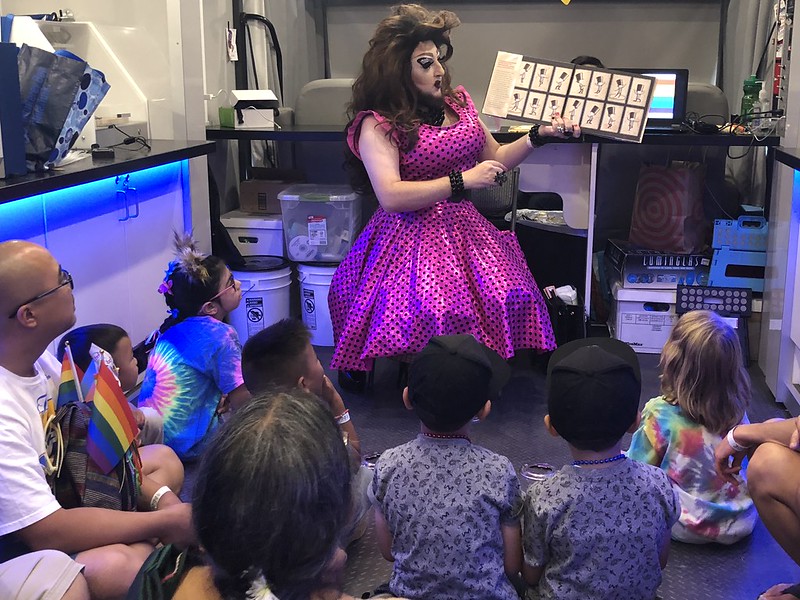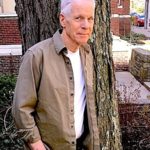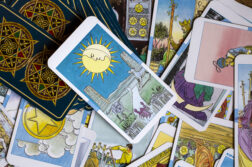
Not too long ago, I was at home watching an episode of RuPaul’s Drag Race. I love the show and must confess, with a mix of pride and embarrassment, that I’ve rarely missed an episode since it premiered in 2009. That said, I couldn’t help but be disappointed by the generic sassy-but-sweet personalities, expensive and flawless outfits, and meticulous makeup. Over the course of the fourteen years the show has been on the air, it’s become increasingly safe and even a little wholesome. I’m not sure how to feel about that.
I’ve always been fascinated by the performative energy and glamour of drag. My first produced play was called Underbelly Blues. In it, a disparate group of struggling characters happen to meet at a freeway on-ramp south of Market Street in San Francisco. The scene stealer in every production was the character Glit, an outrageous drag queen to whom I gave the best lines and the most unnerving story line. When I was working in the East Village theater scene in the 1970s and ’80s, I always wrote roles for drag queens. They brought a rough authenticity to the stage that thrilled and inspired me and at times brought audiences to their feet. They were the opposite of safe and wholesome, and that was a beautiful thing.
But years before I ever wrote a play, I had encounters with drag that have influenced my life to this day. That night, watching Drag Race, a 50-year old memory bubbled up from my subconscious.
It’s early summer of 1963. I’m thirteen years old, and my Dad and I, along with my cousin and best pal Tina, are walking across West 72nd Street on the first leg of a Saturday after-dinner jaunt. It’s a ritual that never fails to thrill and enthrall me. Adding glitter to my excitement, Tina, who is down from Westport for the weekend, has never seen the spectacle and I’m eager to share my wonderment.
We lived around the corner from the donut shop on Central Park West, at the time one of the busiest cruise areas in the world. Our apartment was on the third floor, and my bedroom window faced all the action. So I knew at an early age that I wasn’t the only queer in the world. You didn’t see a lot of queens on CPW because there was a greater chance of being harassed by the cops. I found my natural sympathies were with the queens.
It’s a muggy night and the city has that acrid smell that seems to leach out of the sidewalks. The once grand residential hotels that line 72nd Street look faded and exhausted. The curbs are stuffed with litter. The homeless live in makeshift encampments. You can see the air and black specks cling to your clothing. Sleepy-eyed junkies lurch by in search of their next fix. New York is a struggling city, hollowed out by the white flight to the suburbs. It’s a dismaying but fascinating phenomenon.
But that night sociology isn’t even a blip on my psychic landscape. I love the ratty old city, I’m jazzed up, my adolescent adrenaline pumping with every step. We’re heading to a donut shop, and I’m going to introduce Tina to one of New York’s most fascinating and thrilling tribes.
As we approach Amsterdam Avenue, where the donut shop is, I say to Tina, “Wait until you see the queens.”
Stepping into the donut shop is like stepping onto another planet, one exploding with color and verve and soul and courage. No dying city here. In fact, life seems to explode from the walls. Fluorescent-lit with a horseshow counter, the place smells like cigarettes, cold coffee, cheap perfume, and deep-frying oil, and it’s jammed with mostly Puerto Rican drag queens and hormone-pumping transsexuals chattering and laughing. Because of laws against being in full drag—you have to be wearing at least three articles of the “appropriate sex” or face arrest—they have made-up faces, but no wigs. They favor Capri pants and shirts tied above the navel. They’re vamping and laughing like all get-out, beyond swishy.
Dad orders a dozen donuts while Tina and I gape in wonder. The queens love an audience. One looks at me and runs her hands down her breasts and makes an exaggerated kissy face.
Dad gets the donuts and we walk outside. There’s a small clutch of queens on the sidewalk.
“They’re just being who they are,” Dad says. I can tell he’s fascinated, too.
Two rough-looking teenage boys walk by and start to taunt the queens.
“Fairy Mary-Jane!”
“Sick bitch!”
“I’m gonna kick the shit out of your sissy ass.”
The queens instantly turn into righteous furies, throw back their shoulders, raise their chins and take menacing steps towards the teens, screeching invective in Spanish. The boys are shocked, scared, and cowed; and they split pronto.
“Who’s the sissy now?” I think.
Their display of courage and moxie was the sound of not-so-distant thunder. Three years later, when the Stonewall Riots convulsed the West Village, it was the queens leading the charge. The cops were harassing them and they weren’t going to fucking take it anymore. The streets erupted. Ironically, they were also fighting for the rights of the closeted and uptight homos who shunned them—in those days a lot of gay bars banned drag queens.
After a few nights of rioting, the cops retreated. We won. Those brave queers had led the charge and paved the way for the whole Gay Liberation movement. They are my heroes.
I’m sure many of those long-ago queens would have traded their beautiful defiance for the right to be who they are, to be accepted and respected, to be free from police harassment, random beatings, and so on. I doubt they could imagine that fifty years later, they would be accepted and adored on social media and TV shows and movies. What’s next, The Real Drag Queens of Beverly Hills?
I’m happy for today’s queens, but something has been lost. The grittiest corners of gay culture have been sandpapered smooth. That sense of being an outcast, an outlaw, a rebel, brave and gritty and girly and proud—I miss it. You are not forgotten, fierce flaming creatures.
 Sebastian Stuart was born and raised in New York City. He went to the Grace Church School, the United Nations School, Collegiate and Charles Evans Hughes. Today he lives in Cambridge, Massachusetts with his partner of thirty years, novelist Stephen McCauley. He has a memoir coming out in July 2022 titled What Wasn’t I Thinking? – A Memoir of Rebellion, Madness, and My Mother.
Sebastian Stuart was born and raised in New York City. He went to the Grace Church School, the United Nations School, Collegiate and Charles Evans Hughes. Today he lives in Cambridge, Massachusetts with his partner of thirty years, novelist Stephen McCauley. He has a memoir coming out in July 2022 titled What Wasn’t I Thinking? – A Memoir of Rebellion, Madness, and My Mother.





